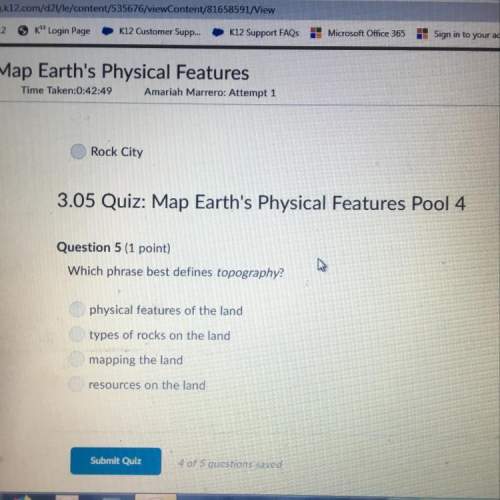
Chemistry, 30.04.2021 19:30 myloredo10
Temperature and Thermal Energy (assignment)
Which of these would have the lowest kinetic energy?
-boiling water
-*ice water
-refrigerated water
-water at room temperature
Joshua is preparing a report to show the relationship between average kinetic energy and temperature. Is his graph accurate? Explain your answer.
-Yes, his graph is correct because it shows that as the average kinetic energy increases, so does the temperature. This is called a direct relationship
Jenny measures the temperature inside a cave to be 10°C. The temperature outside the cave is about 30°C warmer.
How does the kinetic energy of the air molecules inside the cave compare to the kinetic energy of the air molecules outside the cave?
The kinetic energy of the air molecules inside the cave is *less than* the kinetic energy of the air molecules outside the cave.
Which temperature scale has the highest value for the boiling point of water?
*kelvin*
At which temperature does the motion of atoms and molecules stop?
-0°C
-0 C
-0°K
-*0 K
Which scale is being described?
-Water freezes at 32 *degrees fahrenheit*
-Water freezes at 0 *degrees celsius*
-Water freezes at 273 *kelvins*
An outside thermometer reads 57°F. What is this temperature in °C? Round your answer to the nearest whole number.
-*14
-49
-71
-135
Christopher conducts an experiment in which he tests how much sugar dissolves at different temperatures of water. One step requires him to use water with a temperature of 32.5°C. What is this temperature in kelvins? Record your answer to the nearest tenth.
*305.5 K*
Explain what happens to the average kinetic energy, thermal energy, and temperature of a substance when the particles in the substance slow down.
-The particles in a substance slow down when the average kinetic energy of the particles decreases. As the average kinetic energy decreases, the internal energy decreases, and so the thermal energy decreases. As the thermal energy of the substance decreases, the temperature decreases.

Answers: 1
Another question on Chemistry

Chemistry, 21.06.2019 21:40
During trial 2, what allowed you to determine that aluminum was the limiting reactant? check all that apply. all of the copper dissolved. all of the aluminum dissolved. the solution turned clear. the number of grams of copper(ii) chloride used in the reaction was greater than the number of grams of aluminum. the molar ratio of copper(ii) chloride to aluminum was greater than 3: 2, the equation’s molar ratio.
Answers: 2

Chemistry, 21.06.2019 22:30
1.aluminum chloride (alcl3), and sodium hydroxide (naoh) can react to form aluminum hydroxide (al(oh)3) and sodium chloride (nacl). you have 13.4 g of aluminum chloride and 10.0 g of sodium hydroxide. answer the following questions: •what is the balanced equation for this reaction? •if you use all 13.4 g of aluminum chloride, how many grams of aluminum hydroxide can be formed? work must be shown to earn credit •if you use all 10.0 g of sodium hydroxide, how many grams of aluminum hydroxide can be formed? work must be shown to earn credit •how many grams of aluminum hydroxide will actually be made? which reagent is limiting? explain your answer.
Answers: 1

Chemistry, 22.06.2019 07:30
Using data from seismic waves, geologists have learned that earth’s interior is made up of several
Answers: 1

Chemistry, 22.06.2019 12:00
What does a complete balanced chemical equation include? a. exothermic coefficients b. endothermic coefficients c. valence electrons d. molar coefficients
Answers: 1
You know the right answer?
Temperature and Thermal Energy (assignment)
Which of these would have the lowest kinetic energy?
Questions


Mathematics, 07.12.2019 05:31


History, 07.12.2019 05:31



















